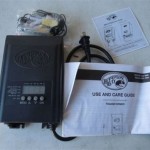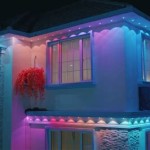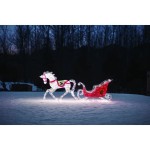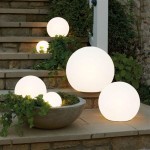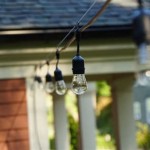Outdoor Solar Motion Sensor Lights: A Comprehensive Guide
Outdoor solar motion sensor lights have become increasingly popular as a security and convenience solution for residential and commercial properties. These lights offer a sustainable and cost-effective way to illuminate outdoor spaces, enhancing safety and deterring potential intruders. Unlike traditional lighting systems, solar motion sensor lights harness sunlight during the day to power their operation at night, eliminating the need for external wiring and reducing electricity bills.
The functionality of these lights combines two core technologies: solar power and motion sensing. Solar panels, typically integrated into the light fixture, convert sunlight into electricity, which is then stored in rechargeable batteries. A motion sensor, usually passive infrared (PIR) or microwave-based, detects movement within a specified range. When motion is detected, the light activates, providing bright illumination for a pre-determined duration. After the motion ceases, the light automatically switches off or dims to a lower setting, conserving energy.
Understanding the nuances of outdoor solar motion sensor lights is essential for selecting the appropriate model for specific needs and ensuring optimal performance. Factors such as light output, detection range, battery capacity, and weather resistance all contribute to the overall effectiveness and longevity of these lighting systems.
Understanding the Components of a Solar Motion Sensor Light
A typical solar motion sensor light comprises several key components, each playing a vital role in its operation. The primary components are the solar panel, the rechargeable battery, the motion sensor, the LED light source, and the housing.
The solar panel is responsible for capturing sunlight and converting it into electrical energy. The efficiency of the solar panel is a crucial factor influencing the light's performance, as it determines how effectively solar energy is converted into usable power. Solar panels are typically made of monocrystalline, polycrystalline, or amorphous silicon. Monocrystalline panels are generally the most efficient, followed by polycrystalline, while amorphous silicon panels are the least efficient but also the most affordable.
The rechargeable battery stores the electrical energy generated by the solar panel. The capacity of the battery determines how long the light can operate at night, especially during periods of limited sunlight. Lithium-ion batteries are commonly used in solar motion sensor lights due to their high energy density, long lifespan, and relatively low self-discharge rate. The battery's voltage and amperage directly influence the light's brightness and duration of operation.
The motion sensor detects movement within its range of coverage. PIR sensors detect changes in infrared radiation caused by the presence of a warm body, while microwave sensors emit microwave radiation and detect changes in the reflected signal caused by moving objects. PIR sensors are generally more energy-efficient but can be susceptible to false triggers from heat sources, while microwave sensors offer a wider detection range and are less prone to false triggers but consume more power. The detection range and sensitivity of the motion sensor are critical factors in determining the light's effectiveness as a security device.
The LED light source provides the illumination. LEDs are energy-efficient, long-lasting, and produce bright, directional light. The brightness of the LED is measured in lumens, with higher lumen values indicating brighter light. The color temperature of the light, measured in Kelvin (K), affects the ambiance of the illuminated area. Warmer color temperatures (e.g., 2700K-3000K) provide a soft, yellowish light, while cooler color temperatures (e.g., 5000K-6000K) emit a bright, white light.
The housing protects the internal components of the light from the elements. The housing is typically made of durable materials such as plastic, aluminum, or stainless steel. Weather resistance, indicated by an IP (Ingress Protection) rating, is a crucial factor in ensuring the light's longevity and performance in outdoor environments. A higher IP rating indicates greater protection against dust and water.
Selecting the Right Outdoor Solar Motion Sensor Light
Choosing the right outdoor solar motion sensor light requires careful consideration of several factors, including the intended use, the size of the area to be illuminated, the amount of sunlight available, and the desired features. Evaluating these factors will help determine the appropriate light output, detection range, battery capacity, and weather resistance for the specific application.
Consider the intended use of the light. Is it primarily for security, convenience, or decorative purposes? For security applications, a brighter light with a longer detection range is generally preferred. For convenience, a light with a wider beam angle and adjustable settings may be more suitable. For decorative purposes, aesthetics may be a more important consideration than performance.
Assess the size of the area to be illuminated. A larger area requires a brighter light with a wider beam angle. Consider the mounting height of the light, as this will affect the illuminated area. A higher mounting height will generally result in a wider coverage area.
Evaluate the amount of sunlight available at the installation location. Solar panels require direct sunlight to generate sufficient power. Ideally, the light should be placed in a location that receives at least six hours of direct sunlight per day. If the location receives limited sunlight, consider a light with a larger solar panel and a high-capacity battery. Consider the geographic location and seasonal variations in sunlight hours.
Determine the desired features. Some solar motion sensor lights offer adjustable settings, such as light duration, detection range, and sensitivity. Some models also include features such as dimming modes, remote control, and smartphone connectivity. Consider the overall aesthetics of the light and choose a model that complements the surrounding environment.
Examine the specifications of the light, including the lumen output, detection range, battery capacity, and IP rating. Compare the specifications of different models to determine the best fit for your needs. Read customer reviews to gain insights into the real-world performance and reliability of the light.
Installation and Maintenance of Solar Motion Sensor Lights
Proper installation and maintenance are essential for ensuring the optimal performance and longevity of outdoor solar motion sensor lights. Following the manufacturer's instructions and performing routine maintenance will help maximize the light's efficiency and lifespan.
Choose a suitable mounting location. The light should be mounted in a location that receives ample sunlight and is free from obstructions such as trees or buildings. Ensure that the mounting surface is sturdy and can support the weight of the light. Consider the desired detection range and adjust the mounting height and angle accordingly. Avoid mounting the light near heat sources or reflective surfaces that could trigger false alarms.
Follow the manufacturer's instructions for installation. Most solar motion sensor lights are easy to install and require minimal tools. Typically, the light is mounted using screws or brackets. Ensure that the light is securely mounted and that the wiring is properly connected (if applicable). If you are unsure about any aspect of the installation process, consult a qualified electrician.
Perform routine maintenance. Regularly clean the solar panel with a soft cloth to remove dirt and debris. This will help ensure that the panel is able to efficiently convert sunlight into electricity. Inspect the battery compartment for corrosion or damage. Replace the battery if necessary. Check the motion sensor for obstructions and clean the lens with a soft cloth.
Adjust the settings as needed. Fine-tune the detection range, sensitivity, and light duration to optimize the light's performance for the specific environment. Consider the time of year and adjust the settings accordingly. During the winter months, when sunlight hours are limited, you may need to reduce the light duration to conserve battery power.
Consider seasonal adjustments. During periods of prolonged cloudy weather, the battery may not fully charge, resulting in reduced performance. In such cases, consider supplementing the solar charging with a manual charge from a power adapter (if supported by the model) or temporarily relocate the light to a sunnier location.
By carefully considering these factors and following proper installation and maintenance procedures, you can ensure that your outdoor solar motion sensor lights provide reliable and efficient illumination for years to come, enhancing the safety and security of your property.
The technology behind solar motion sensor lights continues to evolve, with advancements in solar panel efficiency, battery technology, and motion sensing capabilities. Emerging trends include the integration of smart home connectivity, allowing users to control and monitor their lights remotely via smartphone apps. As the demand for sustainable and energy-efficient lighting solutions grows, outdoor solar motion sensor lights are poised to play an increasingly important role in residential and commercial security and convenience.

20 Led Outdoor Solar Motion Sensor Wall Light

Outdoor Bright 30w Security Solar Motion Sensor Light Cob Led 2500lm

Outdoor Solar Motion Sensor Light Konga Ping

Buy From Best Solar Lights For Garden 100 Led Motion Sensor Security Lamp Home And Outdoors Bright Wireless Night Light Pack

Solar Lights Outdoor Motion Sensor Security 3 Adjustable Head 70 Led 270 Wide Angle Waterproof Wireless Wall For Porch Yard Garage Pathway And More

118 Led Solar Lights Powered Pir Motion Sensor Garden Outdoor Lamp Wall Security

Wbm Smart Low Voltage Solar Powered Black Light Motion Sensing Outdoor 100 Led Path Wall For Yard 2 Pack H Le 11 The Home Depot

Solar Security Motion Sensor Light With Double Led Lamps

Nexpure Solar Lights Outdoor 180 Led Motion Sensor Security Flood With 3 Lighting Modes Ip65 Waterproof For Garage Yard Com

Sol Solar Powered Motion Sensor Outdoor Light Warmly
